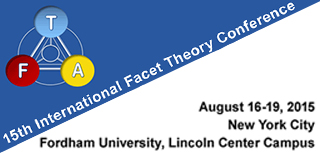Introduction to Facet Theory: Concepts, Examples, and Data Analysis
A workshop conducted by Ingwer Borg (U of Münster, Germany) and Patrick Mair (Harvard, USA)
Facet theory (FT) is a methodology for designing and analyzing empirical research in the social sciences. The objects of interest in the social sciences are almost always multi-faceted, and FT helps to articulate these facets systematically. Intelligence tests, for example, often use tasks presented in numerical, geometric, verbal language; they also require the testee to apply, find, or learn a rule that solves the respective task. The facets language and rule, each with three elements, define nine types of tasks. They guide the construction of concrete test items. The data they generate when using them in testing persons can all be coded on the range “very wrong … very right”. One can then ask whether the two facets are mirrored, facet by facet, in these data in the sense that they allow to discriminate the different item types statistically. For example, one can ask if an analysis of variance with the facets as factors would lead to significant main effects. Another and less restrictive correspondence hypothesis is that the different item types fall into different regions of an MDS representation of the item intercorrelations. These ideas are generalized in FT to domains with many more facets. Attitude research is a prominent example, where items are often constructed by focusing on sub-samples from a population of item types that has hundreds of thousands of elements. In FT, the facets of such populations are usually not just listed, but expressed in the framework of a mapping sentence that shows the roles the facets play relative to each other and relative to what is being observed, that is, the range of the items. Mapping sentences can be extremely useful for systematically picking certain item types from the universe of content and in formulating concrete items that avoid distorting content.
The workshop introduces the basic concepts of facet theory using a set of classic examples. It also shows how FT helps designing and pursuing cumulative theory construction over series of studies, and ranging from exploratory studies to mathematical models. Much emphasis is given to familiarize the participants with data analysis software relevant in the FT context. We concentrate, in particular, on programs available in R, a powerful (free) programming environment for almost any type of statistical data analysis, including publication-ready graphics (see, for example, “The R Project for Statistical Computing“; or books such as Fields et al., 2012). Participants are asked to install R on their computer, so that the data analysis (MDS using Smacof, in particular) can be done hands-on and be interactive. No prior knowledge of R is required!
References
Borg, I. & Shye, S. (1995). Facet theory: Form and content. Newbury Park: Sage
Borg, I., Groenen, P.J.F. & Mair, P. (2013). Applied multidimensional scaling. New York: Springer.
Fields, A., Miles, J., & Field, Z. (2012). Discovering statistics using R. London, UK: Sage.
Installing R and RStudio (just a few clicks!)
(A) Go to http://CRAN.R-project.org (2) Use the link “Download and install R” (3) Specify the operating system of your computer (MS-Windows, Mac OS, Linux), (4) Follow the remaining instructions.
(B) Go to http://rstudio.org and click on “Download RStudio”. (RStudio is a great editor for R.)
For the Program of the Introductory Pre-Conference Workshop follow the PROGRAM link in the FTC Home page.
Subscribe to RSS Feed (Opens in New Window)
